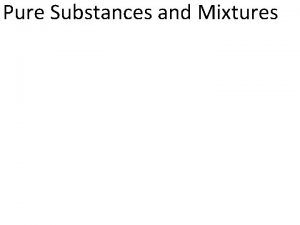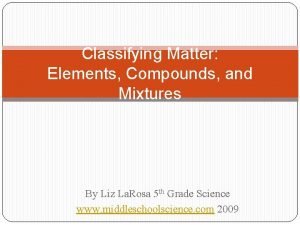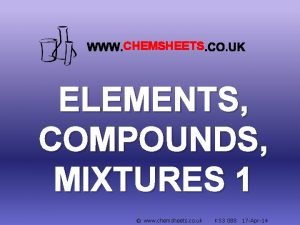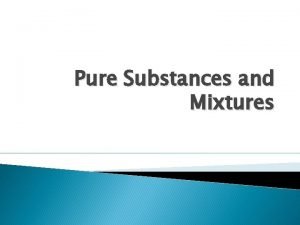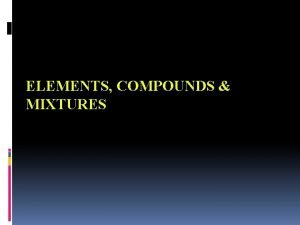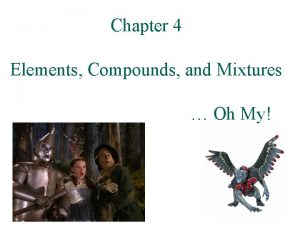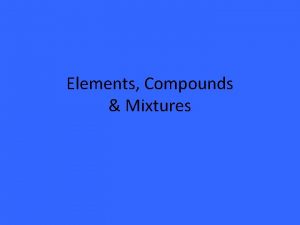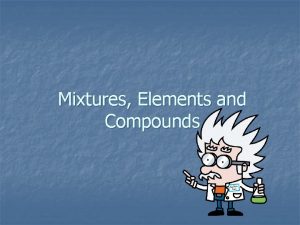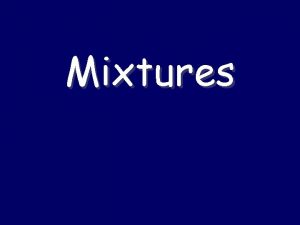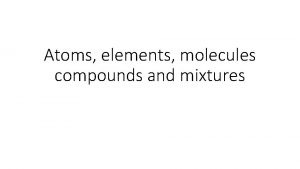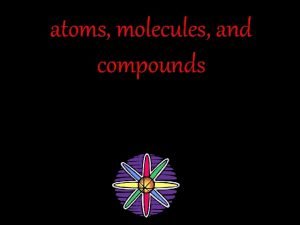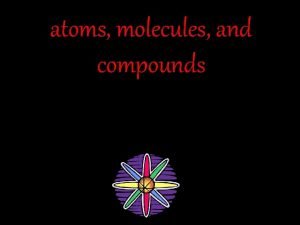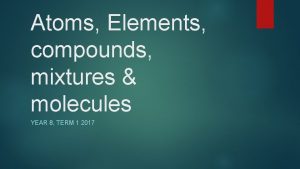Atoms Elements Molecules Compounds and Mixtures 2015 Chemistry








- Slides: 8

Atoms, Elements, Molecules, Compounds and Mixtures 2015 - Chemistry Part B

� An atom is the smallest stable unit of matter. �It takes about 4 MILLION atoms to make the tip of your pencil! WOW! �Atoms consist of several smaller parts. The proton which carries a positive charge and accounts for some of the mass of an atom The neutron which does not carry a charge but still accounts for some of the mass of an atom The electron which carries a negative charge but is has a very small amount of mass. Quarks- Quarks have only recently been discoverednot much is known about them other than they travel in pairs or trios and stay in the nucleus. Protons, neutrons and electrons are called subatomic particles.

� Over time many different models have come along to depict the atom. Models range from a simple circle to intricate drawings displaying depth. � Most changes have happened in the diagrams due to new information becoming available. � Today the 2 most common models are: � The Bohr model and Electron cloud model

� Although the electron cloud model is more accurate it is hard to illustrate because it is proposed that the electrons are moving around randomly. � FOR OUR PURPOSES WE WILL USE THE BOHR MODEL.

� To restate; an atom is the smallest stable piece of matter than makes up other forms of matter. Atoms are made of protons, neutrons and electrons. Protons and neutrons are in the middle of the atom (the nucleus) while electrons orbit the atoms. � So then what is a molecule? �A molecule is 2 or more atoms that are being held together by a bond. Molecules are usually electrically neutral.

� When many of the SAME atoms come together it forms an element. � An element is a collection of the same types of atoms. In other words an element is a pure substance. � Examples of elements include: Hydrogen, gold, silver, aluminum, chlorine and sodium � Compounds, on the other hand are not pure. � A compound is a combination of 2 or more different elements. � Examples of compunds include: Salt, Calcium Carbonate, Iron Nitrate

� Compounds VS. Mixtures � As stated before a compound is when two or more substance are chemically combinedthey have undergone a chemical change and it is impossible to reverse the compound by physical means. � A mixture is when two or more substances have been combined physically and can be the combination can be reversed. Examples include: Hot chocolate; cereal; cookie dough, etc…

� Mixtures can be well mixed together where everything looks the same. This is called homogenous. Ex. Milk � OR � Mixtures can be roughly mixed together where you can still tell what the mixture is made from. This is called heterogeneous. Ex. Chex mix
 Substance
Substance Mixtures worksheet
Mixtures worksheet Elements, compounds and mixtures worksheet with answers
Elements, compounds and mixtures worksheet with answers Difference between mixture and compund
Difference between mixture and compund Types of matter elements compounds and mixtures
Types of matter elements compounds and mixtures Elements compounds and mixtures ks3
Elements compounds and mixtures ks3 Are compounds pure substances
Are compounds pure substances Is sterling silver a pure substance
Is sterling silver a pure substance Elements compounds and mixtures oh my
Elements compounds and mixtures oh my


